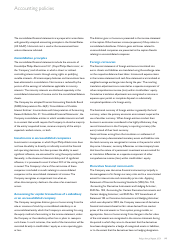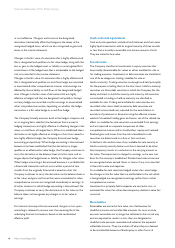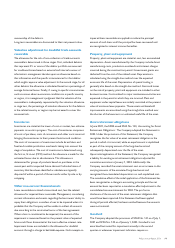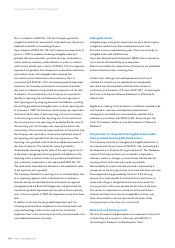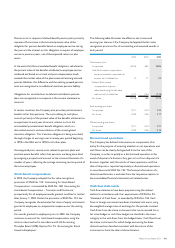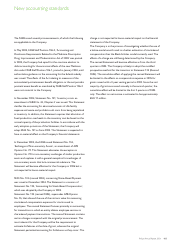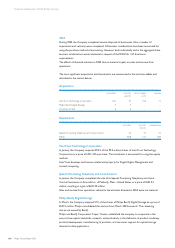Philips 2004 Annual Report Download - page 100
Download and view the complete annual report
Please find page 100 of the 2004 Philips annual report below. You can navigate through the pages in the report by either clicking on the pages listed below, or by using the keyword search tool below to find specific information within the annual report.receivership of the debtors.
Long-term receivables are discounted to their net present value.
Valuation adjustment for doubtful trade accounts
receivable
The allowance for the risk of non-collection of trade accounts
receivable is determined in three stages. First, individual debtors
that represent 3% or more of the debtor portfolio are assessed
for creditworthiness based on external and internal sources of
information; management decides upon an allowance based on
that information and the specific circumstances for that debtor
which might require a value adjustment. In the second stage, for all
other debtors the allowance is calculated based on a percentage of
average historical losses. Finally, if, owing to specific circumstances
such as serious adverse economic conditions in a specific country
or region, it is management’s judgment that the valuation of the
receivables is inadequately represented by the valuation allowance
in stage two, the percentage of valuation allowance for the debtors
in the related country or region may be increased to cover the
increased risk.
Inventories
Inventories are stated at the lower of cost or market, less advance
payments on work in progress. The cost of inventories comprises
all costs of purchase, costs of conversion and other costs incurred
bringing the inventories to their present location and condition.
The costs of conversion of inventories include direct labor and
fixed and variable production overheads, taking into account the
stage of completion. The cost of inventories is determined using
the first-in, first-out (FIFO) method. An allowance is made for the
estimated losses due to obsolescence. This allowance is
determined for groups of products based on purchases in the
recent past and/or expected future demand. Individual items of
inventory that have been identified as obsolete are typically
disposed of within a period of three months either by sale or by
scrapping.
Other non-current financial assets
Loans receivable are stated at amortized cost, less the related
allowance for impaired loans receivable. Management, considering
current information and events regarding the borrowers’ ability to
repay their obligations, considers a loan to be impaired when it is
probable that the Company will be unable to collect all amounts
due according to the contractual terms of the loan agreement.
When a loan is considered to be impaired, the amount of the
impairment is measured based on the present value of expected
future cash flows discounted at the loan’s effective interest rate.
Impairment losses are included in the allowance for doubtful
accounts through a charge to bad debt expense. Cash receipts on
impaired loans receivable are applied to reduce the principal
amount of such loans until the principal has been recovered and
are recognized as interest income thereafter.
Property, plant and equipment
Property, plant and equipment are stated at cost, less accumulated
depreciation. Assets manufactured by the Company include direct
manufacturing costs, production overheads and interest charges
incurred during the construction period. Government grants are
deducted from the cost of the related asset. Depreciation is
calculated using the straight-line method over the expected
economic life of the asset. Depreciation of special tooling is
generally also based on the straight-line method. Gains and losses
on the sale of property, plant and equipment are included in other
business income. Costs related to major maintenance activities are
expensed in the period in which they are incurred. Plant and
equipment under capital leases are initially recorded at the present
value of minimum lease payments. These assets and leasehold
improvements are amortized using the straight-line method over
the shorter of the lease term or estimated useful life of the asset.
Asset retirement obligations
In June 2001, the FASB issued SFAS No. 143, ‘Accounting for Asset
Retirement Obligations’. The Company adopted this Statement in
2003. Under the provisions of this Statement, the Company
recognizes the fair value of an asset retirement obligation in the
period in which it is incurred, while an equal amount is capitalized
as part of the carrying amount of the long-lived asset and
subsequently depreciated over the life of the asset.
Upon initial application of the Statement, the Company recognized
a liability for existing asset retirement obligations adjusted for
cumulative accretion to January 1, 2003. Additionally, the
Company recorded the asset retirement cost as an increase to the
carrying amounts of the associated long-lived assets and
recognized the accumulated depreciation on such capitalized cost.
The cumulative effect of the initial application of the Statement has
been recognized as a change in accounting principle and the net
amount has been reported as a cumulative-effect adjustment in the
consolidated income statement for 2003. The pro forma
disclosure of the amount of the asset retirement obligation that
would have been reported if the Statement had been applied
during all periods affected, has been omitted because the amounts
were not material.
Goodwill
The Company adopted the provisions of SFAS No. 141 as of July 1,
2001 and SFAS No. 142 as of January 1, 2002. Goodwill is not
amortized but tested for impairment annually in the second
quarter or whenever impairment indicators require so.
99Philips Annual Report 2004










